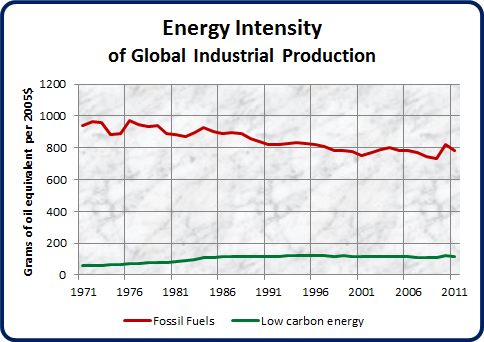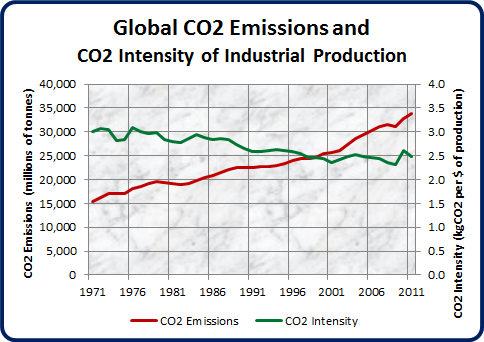Environment & Energy
Related: About this forumIncreased use of low-carbon energy may not cut CO2 emissions.
Last edited Mon Nov 25, 2013, 04:18 PM - Edit history (1)
This post provides a quick look at how much low carbon (aggregated hydro, nuclear and renewable) and fossil fuel energy has been used in global industrial production since 1970. The purpose of the post is to look for evidence that low-carbon energy has displaced fossil fuels over the last 40 years.
The question that prompts this assessment is “What is the likelihood that increasing amounts of low-carbon energy can reverse the growth of fossil fuels?” Although that question can’t be answered completely by looking at the past, we can perhaps gain some insight into how the global economy has previously responded to the growth of low-carbon energy supplies.
In the analysis I used the World Bank’s data on industrial production in constant 2005 dollars. I used industrial activity in order to avoid some of the uncertainty introduced by the inclusion of non-physical activities like finance in traditional GDP calculations. This is at the expense of introducing additional uncertainty, because industrial production data does not account for domestic energy use. Energy and CO2 data are from the BP Statistical Review 2013 as usual.
The first graph looks at the amount of low and high carbon energy embedded in each dollar's worth of global industrial production.

The data shows three distinguishable time periods with different characteristics: 1971 to 1985, 1986 to 2001, and 2001 to today.
From 1971 to 1985, the amount of fossil fuel required to produce a dollar’s worth of industrial output declined, while the amount of low carbon energy (a combination of hydro and nuclear power) rose. This indicates that low-carbon sources were in fact displacing fossil fuels over that period.
In 1985, though, the picture changed in a small but significant way. The amount of embedded low-carbon energy plateaued, while the embedded fossil fuels continued to fall. This seems to indicate that the energy efficiency of fossil fuel applications continued to improve over the following 15 years, but the displacing of fossil fuels by low-carbon energy stopped. This low-carbon plateau remains in effect today.
In 2001, China’s industrialization began in earnest. It was driven by coal, and its effect can be seen as a flattening of the fossil fuel line. China’s entry onto the world industrial stage had no impact on the energy intensity of low-carbon energy. I would speculate that continuing FF efficiency improvements in the rest of the world balanced out the increased use of fossil fuels by China, but this is just speculation at this point.
The next graph shows the global emissions curve for CO2 as well as the carbon intensity of each dollar of industrial output.

Carbon intensity improved a little in 1971-1985, significantly more in 1986-2001, but not at all since 2001. The effect of Chinese industry is again clear. However, one point jumps out at me – carbon emissions don’t correlate well with CO2 intensity of industrial activity. Even during periods of declining carbon intensity the emissions keep rising – unless there is a global recession that suppresses industrial output (as happened in 1974-75, 1981-83 and 2001-2 and 2009-10).
Correlations
This linkage of carbon emissions to industrial activity is also demonstrated in two calculated correlations. The correlation of CO2 emissions to industrial output over the 40 years from 1971 to 2011 is 99%. However, the correlation of CO2 emissions to CO2 intensity of industrial production over the same period is only 84%. The implication of this difference is that that the main driver of CO2 emissions is the level of industrial activity, NOT the amount of low-carbon energy in the global energy mix. The data shows that the addition of low-carbon energy can slow the rise of CO2 emissions as the economy grows, but there is nothing in this evidence to suggest that adding low-carbon sources can reverse the rise in atmospheric CO2.
Conclusion
In the current global economic situation, with no universal regulation of carbon consumption, the only way to reduce CO2 emissions is through a reduction in economic activity. The simple addition of hydro, nuclear and/or renewable power doesn't seem likely to accomplish what is currently hoped for by all parties.
In order to replace fossil fuels with low-carbon energy we would probably have to restrict the use of fossil fuels, globally. I know of no way to do that in a global civilization made up of sovereign nations - which explains why people have opted instead for the "hope-and-grope" of the renewable build-out. That won't work because price alone doesn't prompt replacement if the original energy source is more fit for the intended purpose. It's why electricity isn't replacing automotive gasoline. There are system issues that must be taken into account.
If we want to reduce CO2 emissions, we are far more likely to be able to do it by working to reduce global economic output than by throwing more wind, solar or even nuclear power at the problem.
So it goes.